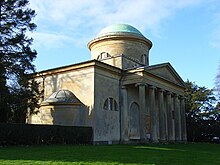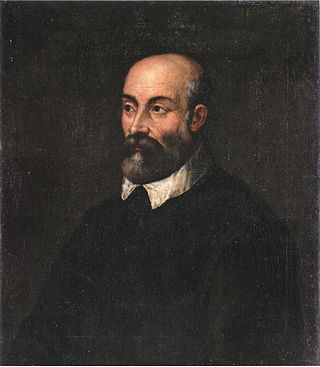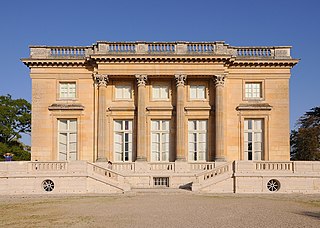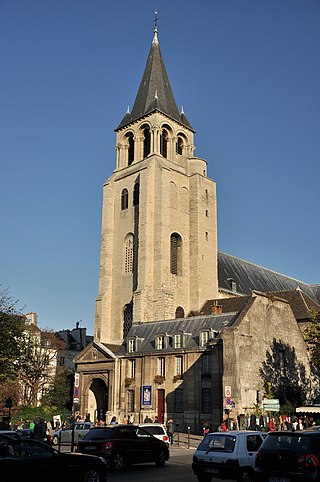Events
- Robert Adam's Ruins of the Palace of the Emperor Diocletian at Spalatro in Dalmatia published.
- Heidelberg Castle (Holy Roman Empire, Germany) is again burned and destroyed by a thunderbolt.



| |||
|---|---|---|---|
| Buildings and structures +... |
The year 1764 in architecture involved some significant events.




Victorian architecture is a series of architectural revival styles in the mid-to-late 19th century. Victorian refers to the reign of Queen Victoria (1837–1901), called the Victorian era, during which period the styles known as Victorian were used in construction. However, many elements of what is typically termed "Victorian" architecture did not become popular until later in Victoria's reign, roughly from 1850 and later. The styles often included interpretations and eclectic revivals of historic styles (see Historicism). The name represents the British and French custom of naming architectural styles for a reigning monarch. Within this naming and classification scheme, it followed Georgian architecture and later Regency architecture and was succeeded by Edwardian architecture.

Andrea Palladio was an Italian Renaissance architect active in the Venetian Republic. Palladio, influenced by Roman and Greek architecture, primarily Vitruvius, is widely considered to be one of the most influential individuals in the history of architecture. While he designed churches and palaces, he was best known for country houses and villas. His teachings, summarized in the architectural treatise, The Four Books of Architecture, gained him wide recognition.
This is a timeline of architecture, indexing the individual year in architecture pages. Notable events in architecture and related disciplines including structural engineering, landscape architecture, and city planning. One significant architectural achievement is listed for each year.

Palladian architecture is a European architectural style derived from the work of the Venetian architect Andrea Palladio (1508–1580). What is today recognised as Palladian architecture evolved from his concepts of symmetry, perspective and the principles of formal classical architecture from ancient Greek and Roman traditions. In the 17th and 18th centuries, Palladio's interpretation of this classical architecture developed into the style known as Palladianism.
The year 1855 in architecture involved some significant architectural events and new buildings.
The year 1806 in architecture involved some significant events.
The year 1814 in architecture involved some significant events.

James Gandon was an English architect best known for his work in Ireland during the late 18th century and early 19th century. His better known works include The Custom House and the surrounding Beresford Place, the Four Courts and the King's Inns in Dublin and Emo Court in County Laois.

Neoclassical architecture, sometimes referred to as Classical Revival architecture, is an architectural style produced by the Neoclassical movement that began in the mid-18th century in Italy, France and Germany. It became one of the most prominent architectural styles in the Western world. The prevailing styles of architecture in most of Europe for the previous two centuries, Renaissance architecture and Baroque architecture, already represented partial revivals of the Classical architecture of ancient Rome and ancient Greek architecture, but the Neoclassical movement aimed to strip away the excesses of Late Baroque and return to a purer, more complete, and more authentic classical style, adapted to modern purposes.
Events concerning Architecture from the year 1736.

Giuseppe Venanzio Marvuglia was an Italian architect.
The year 1727 in architecture involved some significant events.

London's architectural heritage involves many architectural styles from different historical periods. London's architectural eclecticism stems from its long history, continual redevelopment, destruction by the Great Fire of London and The Blitz, and state recognition of private property rights which have limited large-scale state planning. This sets London apart from other European capitals such as Paris and Rome which are more architecturally homogeneous. London's architecture ranges from the Romanesque central keep of The Tower of London, the great Gothic church of Westminster Abbey, the Palladian royal residence Queen's House, Christopher Wren's Baroque masterpiece St Paul's Cathedral, the High Victorian Gothic of The Palace of Westminster, the industrial Art Deco of Battersea Power Station, the post-war Modernism of The Barbican Estate and the Postmodern skyscraper 30 St Mary Axe 'The Gherkin'.

James Smith was a Scottish architect, who pioneered the Palladian style in Scotland. He was described by Colen Campbell, in his Vitruvius Britannicus (1715–1725), as "the most experienced architect of that kingdom".

The "Battle of the Palaces" occurred in the Russian Empire in the last decade of the reign of Catherine II (1784–1796) and the reign of Paul I (1796–1801), with ripple effects extending into the beginning of the reign of Alexander I. A bitter standoff between Catherine and Paul, her only legitimate son and heir, manifested itself in transient political and ideological conflicts, but also had a lasting, tangible impact on Russian architecture. Both parties materialized their political statements and their understanding of sovereign power in expensive construction projects involving the most illustrious architects of the period – Vasily Bazhenov, Vincenzo Brenna, Charles Cameron, Matvey Kazakov, Giacomo Quarenghi, and Ivan Starov. Catherine's palace projects followed the neoclassical canon of the Age of Enlightenment, while Paul deliberately leaned to emerging Romanticism. Buildings that stylistically fell apart from these programs were demolished or rebuilt without hesitation. The "battle" began in 1785 with the demolition of the main palace in Tsaritsyno, and culminated in 1796 with the demolition of Pella, the largest imperial palace in the Saint Petersburg area.

Architecture in early modern Scotland encompasses all building within the borders of the kingdom of Scotland, from the early sixteenth century to the mid-eighteenth century. The time period roughly corresponds to the early modern era in Europe, beginning with the Renaissance and Reformation and ending with the start of the Enlightenment and Industrialisation.

The city of Paris has notable examples of architecture of every period, from the Middle Ages to the 21st century. It was the birthplace of the Gothic style, and has important monuments of the French Renaissance, Classical revival, the Flamboyant style of the reign of Napoleon III, the Belle Époque, and the Art Nouveau style. The great Exposition Universelle (1889) and 1900 added Paris landmarks, including the Eiffel Tower and Grand Palais. In the 20th century, the Art Deco style of architecture first appeared in Paris, and Paris architects also influenced the postmodern architecture of the second half of the century.

Neoclassical architecture in Russia developed in the second half of the 18th century, especially after Catherine the Great succeeded to the throne on June 28, 1762, becoming Empress of Russia. Neoclassical architecture developed in many Russian cities, first of all St. Petersburg, which was undergoing its transformation into a modern capital throughout the reign of Catherine II.